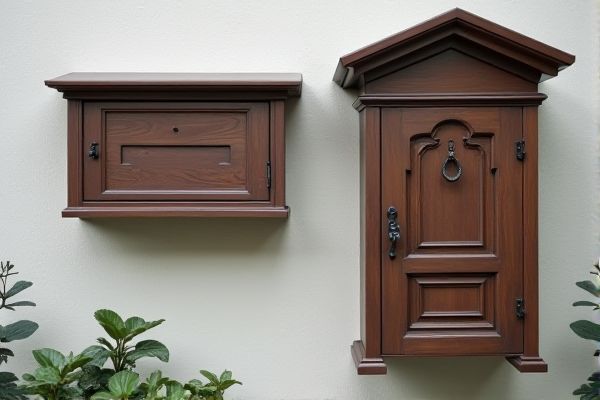
A wall-mounted mailbox saves space and offers easy access right at your doorstep, making it ideal for homes with limited outdoor areas, while a freestanding mailbox provides more capacity and flexibility in placement. Explore the rest of this article to discover which option best suits your needs and enhances your home's curb appeal.
Table of Comparison
| Feature | Wall-Mounted Mailbox | Freestanding Mailbox |
|---|---|---|
| Installation | Mounts directly on walls or pillars | Installs on posts or stands in the ground |
| Space Efficiency | Saves ground space, ideal for small areas | Requires dedicated ground space |
| Accessibility | Mounted at convenient height for easy access | Adjustable height depending on post installation |
| Durability | Depends on wall material and mounting method | Generally stable, affected by environmental exposure |
| Design Options | Limited to wall-compatible styles | Wide variety of sizes, shapes, and styles available |
| Security | Often more secure due to fixed mounting | Can be vulnerable to tampering if not secured properly |
| Cost | Typically lower installation cost | May include additional costs for post and installation |
| Ideal Use | Urban areas, apartments, or homes with limited yard space | Suburban or rural settings with ample yard space |
Introduction to Mailbox Types
Wall-mounted mailboxes attach directly to a home or building, offering a compact and secure option ideal for limited space and easy mail retrieval. Freestanding mailboxes stand independently on posts, providing greater visibility and often more storage capacity for larger volumes of mail or packages. Both types require weather-resistant materials and compliance with USPS regulations to ensure efficient and secure mail delivery.
Key Differences Between Wall-Mounted and Freestanding Mailboxes
Wall-mounted mailboxes attach directly to your home or a nearby wall, offering a compact and secure option perfect for areas with limited space, while freestanding mailboxes are installed on posts or stands, providing greater versatility in placement and often featuring larger storage capacity. Wall-mounted units typically require proximity to your front door for easy access, whereas freestanding mailboxes are designed to be placed curbside, allowing for convenient mail delivery by postal workers. Choosing between the two depends on your property layout, space availability, and personal preferences for mailbox accessibility and style.
Installation Requirements and Complexity
Wall-mounted mailboxes require sturdy wall surfaces and secure mounting hardware, making installation generally straightforward but dependent on appropriate wall material such as brick, wood, or siding. Freestanding mailboxes need a post installation, often involving digging, concrete setting, and ensuring stability, which elevates the complexity and time required for setup. Your choice between these options should consider the installation effort you are prepared to invest and the structural requirements of your property.
Space and Location Considerations
Wall-mounted mailboxes save space by attaching directly to your home or a nearby structure, making them ideal for properties with limited yard area or narrow driveways. Freestanding mailboxes require more room for placement, often positioned at the curb, which suits homes with larger front lawns or driveways that allow easy access for postal delivery. Your choice between these options depends on your property's layout and how much outdoor space you can allocate for secure, convenient mail receiving.
Security Features and Mail Protection
Wall-mounted mailboxes offer enhanced security features by being firmly attached to your home's exterior, reducing the risk of theft or tampering. Their enclosed design typically includes locked compartments that protect mail from weather exposure and unauthorized access. Freestanding mailboxes, while often larger and more accessible, may require additional security measures such as heavy-duty locks or strategic placement to ensure optimal mail protection.
Durability and Weather Resistance
Wall-mounted mailboxes typically offer enhanced durability due to their fixed position against a sturdy surface, reducing exposure to harsh elements and minimizing damage from strong winds or collisions. Freestanding mailboxes require materials like galvanized steel or heavy-duty aluminum to withstand weather conditions, but they are more susceptible to rust, corrosion, and physical impact. To ensure your mailbox remains weather-resistant and durable, consider factors such as material quality, protective coatings, and installation location.
Design Aesthetics and Curb Appeal
Wall-mounted mailboxes provide a sleek, integrated look that complements modern home facades and enhances curb appeal with minimal visual disruption. Freestanding mailboxes offer versatile design options, often acting as a statement piece in landscaping, which can significantly boost a property's overall aesthetic charm. Choosing between the two depends on the desired architectural style, with wall-mounted mailboxes suiting urban or compact spaces and freestanding models enhancing traditional or spacious settings.
Maintenance and Longevity
Wall-mounted mailboxes generally require less maintenance due to their secure attachment to walls, reducing exposure to ground moisture and physical damage. Freestanding mailboxes often demand more frequent upkeep because they are susceptible to rust, leaning, or damage from lawn equipment and weather conditions. Choosing materials like galvanized steel or weather-resistant polymers for either type enhances longevity and minimizes the need for repairs.
Cost Comparison: Initial and Long-Term
Wall-mounted mailboxes generally have a lower initial cost due to simpler installation requirements and fewer materials compared to freestanding mailboxes, which often require a post and more durable construction. In terms of long-term expenses, freestanding mailboxes may incur higher maintenance costs because of exposure to ground moisture and potential damage from vehicles or landscaping activities. Your choice will influence both upfront investment and ongoing upkeep, with wall-mounted models offering budget-friendly solutions while freestanding options may demand additional care over time.
Choosing the Right Mailbox for Your Needs
Wall-mounted mailboxes save space and offer easy access by attaching directly to your home, ideal for smaller properties or areas with limited ground space. Freestanding mailboxes provide greater capacity and flexibility in placement, often featuring larger compartments for bulkier mail or packages. You should consider your home's layout, mail volume, and security preferences when choosing the right mailbox for your needs.
 homyna.com
homyna.com